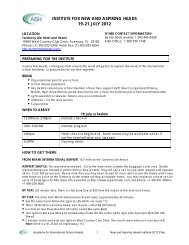AISHnet Survey - Academy for International School Heads
AISHnet Survey - Academy for International School Heads
AISHnet Survey - Academy for International School Heads
Create successful ePaper yourself
Turn your PDF publications into a flip-book with our unique Google optimized e-Paper software.
assessment, members must first clarify the specific<br />
knowledge and understanding, reasoning proficiencies,<br />
per<strong>for</strong>mance skills, and product development capabilities<br />
each student is to master. To create a common<br />
assessment, team members must build shared<br />
knowledge of relevant state standards, district curriculum<br />
guides, state assessment frameworks, and the<br />
expectations of the teachers in the next course or<br />
grade level in order to clarify the intended learning <strong>for</strong><br />
students. Rather than interpreting standards in isolation,<br />
team members ensure that they share similar interpretations<br />
of standards and are assigning similar<br />
priorities to each.<br />
Deconstructing standards into the scaffolding students<br />
will climb to arrive at the intended learning is<br />
best done, not by individuals working in isolation but<br />
by teams and professional interaction within a professional<br />
learning community.<br />
Common assessments can contribute to assessment<br />
quality. The team structure provides a powerful<br />
<strong>for</strong>mat by which teachers can learn how to create<br />
high-quality assessments. A team working with the<br />
benefit of clearly defined learning targets and enhanced<br />
assessment literacy is in a position to create<br />
high-quality assessments that foster student learning.<br />
To illustrate, a team can apply the keys to quality<br />
in developing per<strong>for</strong>mance assessments. Team members<br />
must agree on criteria <strong>for</strong> assessing student work<br />
and then practice applying those criteria until they<br />
can score the work consistently (that is, until they establish<br />
inter-rater reliability). This dialogue fosters<br />
both greater clarity of the learning standard to be<br />
644 PHI DELTA KAPPAN<br />
achieved and higher quality assessments.<br />
Common assessments can enhance communication.<br />
Clarity regarding achievement expectations and<br />
the methods <strong>for</strong> gathering evidence of student learning<br />
can help a team create a common vision. Furthermore,<br />
if teachers trans<strong>for</strong>m those learning targets into<br />
student-friendly terms and share them with their students<br />
from the beginning of instruction, evidence of<br />
learning can be more quickly and easily communicated<br />
to and understood by students. As a result, students<br />
and teachers can collaborate in pinpointing<br />
what comes next in the learning and acting on that<br />
in<strong>for</strong>mation.<br />
STUDENT-INVOLVED COMMON ASSESSMENT<br />
FOR LEARNING<br />
While we tend to think of assessment as something<br />
adults do to students to verify their learning, students<br />
also assess themselves. This reality also can feed into<br />
the productive use of common <strong>for</strong>mative assessments.<br />
For example, if the learning process starts with student-friendly<br />
versions of learning targets, students<br />
can become partners in creating and using practice assessments.<br />
Practice events can focus student attention<br />
on the keys to success and show students their<br />
progress as they move toward mastering standards.<br />
This understanding of learning targets and practice<br />
with such assessments enables students to become<br />
partners in interpreting results of common assessments<br />
and brainstorming how to respond when results<br />
show that students struggle across classrooms to<br />
master certain standards. Throughout this phase, to<br />
the extent that students are involved in the practice<br />
assessment and record-keeping processes, they will<br />
develop the conceptual understanding and vocabulary<br />
needed to communicate effectively with others<br />
about their achievement and improvement over time.<br />
Such involvement has been linked to profound gains<br />
in student learning (Hattie and Timperley 2007).<br />
In the final analysis, the ultimate test of effective<br />
assessment is simple — does it provide teachers and<br />
students with the in<strong>for</strong>mation they need to ensure<br />
that all students learn at higher levels. K<br />
REFERENCES<br />
Hattie, John, and Helen Timperley. “The Power of<br />
Feedback.” Review of Educational Research 77, no. 1<br />
(2007): 81-112.<br />
Stiggins, Richard J. Assessment Manifesto: A Call <strong>for</strong><br />
the Development of Balanced Assessment Systems.<br />
Princeton, N.J.: Educational Testing Service, 2008.



